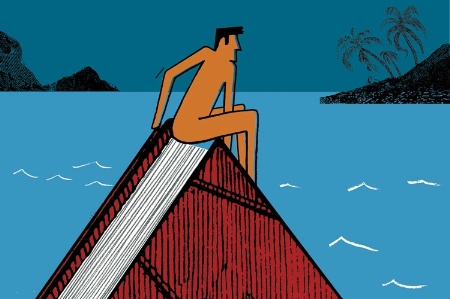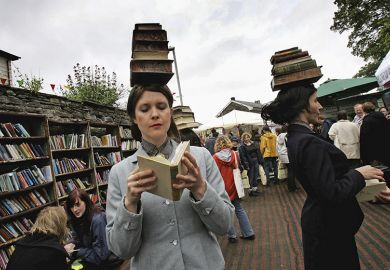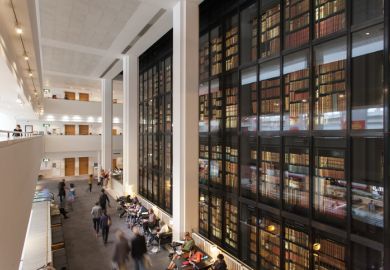Source: Frazer Hudson
If I could clean up a 300-page dissertation in a couple of days, surely I could scrub down a 25-page chapter before breakfast?
Over a 30-year academic career, I’ve developed a short list of things I’d rather not do, given the choice. Here are the top three, in roughly descending order of undesirability:
- Serving on any university committee charged with budgets, fundraising or building projects
- Leading US students on study tours to countries where they can legally start drinking at breakfast (a few hours after they return from the bars)
- Participating in any event where academic faculty are required to dress up as extras in a Shakespearean drama (in other words, most formal academic occasions).
To this list I am now adding a fourth: co-editing an academic volume of contributed chapters.
When I took on just such an assignment in early 2013, it sounded like a worthwhile, intellectually stimulating project that would broaden my knowledge of current research on journalism and media around the world. Now, almost 18 months later, I and my co-editor Yusuf Kalyango, Jr, associate professor of journalism at Ohio University, feel as if we’ve been cast adrift, bobbing around in a sea of hazardous research, murky theory and citations that sting and bite. We finally staggered ashore – a month or so after the publisher’s absolute-definite-final-non-negotiable manuscript deadline. We nonchalantly described our voyage to colleagues as challenging, demanding or testing. It would have been much too embarrassing to admit that there were times when we didn’t think we’d make it.
I had come to the project with some local notoriety as an academic editor. For years, postgraduate students in communications and journalism had either sought me out – or strategically avoided me – because of my reputation for reducing whatever they wrote by at least 33 per cent, without loss of content or meaning. Some protested at the page and word limits I set for my classes. “I am challenging such-and-such a theory, so I can’t possibly present my research in less than 30 pages,” they would whine. To which I responded, “Aim for 15, and I’ll cut it to 10.”
It usually wasn’t hard. Once I’d taken out the filler in the literature review, discarded tangential theories, ditched multiple restatements of the hypothesis, pruned dependent clauses, trimmed excessive adjectives, purged quotation marks used as qualifiers, kicked out convoluted constructions and (parenthetically) expelled phrases from their cocoon-like parentheses, I was close to my target.
I rapidly dissected dissertations, theses, research papers and conference and journal submissions, serving them up again in smaller, more palatable portions. Lessons I had learned as a newspaper sub-editor and as a television news writer served me well in academe. My mantra was a sign on the wall of a colleague’s office that playfully perverted Abraham Maslow’s hierarchy of needs:
The basic human need is:To eat.
To sleep.
To edit someone else’s copy.
Driven by the primeval copy-editing urge, I agreed to take on the nitty-gritty task of revising and editing contributions for a volume on global journalism and new media. If I could clean up a 300-page dissertation in a couple of days, surely I could scrub down a 25-page chapter before breakfast? My calculations proved sadly wrong.
Edited volumes in the humanities and social sciences generally fall into two categories. In the first, you invite established scholars to contribute chapters in their areas of expertise. As editors, you focus the volume thematically and write an introduction and conclusion connecting the contributions. There is busywork – checking references and compiling the index – but you usually don’t have to worry about the quality of the scholarship.
The second category recycles papers presented at a conference or symposium. In my discipline, programme chairs often make conference themes exceptionally broad to attract as many papers as possible; you can get away with almost anything at a conference on “New Perspectives on Media and Culture”. Unlike the first category, where you work with authors to shape their chapters according to the theme, the second is more hit-and-miss because conferences yield interesting but disparate papers. However, any creative editor can find a connection between “Information Technologies and Tribal Identity in Papua New Guinea” and “Meta-Textuality in The Real Housewives of New Jersey”. Both have “new” in the title. That’s a start.
Unfortunately, Yusuf and I had neither established scholars nor conference papers for our volume. We had set ourselves a challenge worthy of reality TV: take a group of educators with vastly disparate knowledge, research and language skills and have them produce a publishable book.

Then there were those we rejected. Apparently one author missed not only our sessions on research methods but also the one on plagiarism
Every year since 2010, Ohio University has hosted the Study of the US Institute (SUSI) on Journalism and Media, a six-week summer programme for journalism and media educators from around the world funded by the US Department of State’s Bureau of Educational and Cultural Affairs. In 2013, we invited participants from the first three cohorts to submit chapters on media in their own countries. A few had experience in academic research and writing. Most did not, but wanted to make the transition to become teacher-scholars. A chapter in an academic volume, published in English, would enhance their status at their institutions, maybe even help to earn them a promotion or a pay rise.
We will never know how many of them embarked on a chapter but gave up when they realised how much effort it was going to take. Six months after the initial call for contributions, we sent polite reminders to those who had promised to submit. Some were nowhere to be found, at least on email and social media. We ended up with 20 submissions. Now it was time to see what they had learned from the summer programme about research design, quantitative and qualitative methods and how to write up the results.
Half a dozen contributors met or exceeded our expectations, producing well-researched studies grounded in theory. Because most were writing in English for the first time, we needed several drafts to clarify arguments and clean up the language. Other chapters underwent major surgery, both for content and language. “Don’t assume a reader knows anything about your country,” I told contributors, urging them to add historical, political, economic and cultural context. Some spouted opinions as self-evident truths. I would write: “You can’t just say, ‘It is well known that media are the puppets of political parties.’ What’s the evidence?” Some had apparently recently taken a course on “Using Graphics to Enhance Your Research”, because they littered the text with tables, bar graphs and pie charts that added colour but no new information. Over the months, I went back and forth with the authors. Some chapters went through eight or nine drafts.
And then there were the contributions we rejected. One author presented a dozen tables from his online survey of 140 respondents on “interactive communication” by young people in his country. Although his study cited the United Nations Educational, Scientific and Cultural Organisation’s definition of youth (15 to 24 years old), only 8 per cent of respondents were in this age range. Indeed, only 20 per cent were under the age of 30, and almost one-third were over 40. In other words, the survey sample had absolutely no relationship to the research question. The researcher was asking older, mostly university-educated individuals how young people’s communication habits were changing. They gave socially acceptable responses. Young people, they said, were motivated to use the internet to build “mutual understanding”. Only a few admitted to looking for love or marriage online. “Research totally flawed,” I wrote to Yusuf, “and we’ll be academic dead meat if we try to use this one.” We dropped it.
In another contribution (also rejected), I was puzzled as to why the most recent statistics on community radio were from 2007. Weren’t there more recent numbers? The writing style also seemed uneven. In some sections, I made corrections in almost every sentence; in others, the argument flowed logically and clearly, with almost no grammatical errors. I inserted one key phrase into a search engine. At least one-third of the chapter had been lifted, word for word, from a 2007 Unesco report on community radio (which explained why the data did not go beyond that year). Apparently, the author missed not only our sessions on research methods but also the one on plagiarism. He did not respond to emails.
By late March of this year, with a 1 April deadline, we had 15 edited chapters, some of which had gone through multiple revisions. I thought my voyage was over. But we had not reckoned with the time and effort it would take to clean up references and compile the bibliography. I was cast adrift again.
As the chapters had been revised, the names of authors cited had been flipped or garbled, journal articles had shed their volume numbers and dates, and the format had gone to APA (American Psychological Association) Style hell. The references to online sources were the most troublesome. Some URLs went nowhere. There were broken links, and mysterious redirects to Chinese- and Turkish-language blog posts. My browsing history for a few days consisted mostly of “Error 404: Article Not Found”, “Please contact your network administrator” and “Oops! Page Not Found”.
I should have paid more attention to the references while I was editing, but I was too busy helping the contributors focus their research, build arguments and tidy up the grammar and spelling. Naively, I thought we could sort out the references in a few hours after we had final versions. It took the best part of a month (after the publisher’s deadline) to find working URLs for all online sources, and to add translations of titles from Spanish, Turkish, Arabic and Surinamese Dutch.
The contributors who persevered benefited from the process. They gained more than an extra line on their CV or annual performance report, a note from their dean or even a pay rise. Many wrote warm thank-you notes saying how much they had learned, and that they felt more confident about presenting their research at conferences or submitting journal articles. That, of course, was always our goal: to help academics whose primary job was teaching to undertake research.
A few contributors even suggested that we do it all over again. “What’s our next book going to be?” they asked cheerily. I didn’t want to tell them that once was enough for me and that I had added “co-editing an academic volume of contributed chapters” to my avoid-if-at-all-possible list. I wrote back to tell them that I hoped they were now ready to make solo voyages.
Register to continue
Why register?
- Registration is free and only takes a moment
- Once registered, you can read 3 articles a month
- Sign up for our newsletter
Subscribe
Or subscribe for unlimited access to:
- Unlimited access to news, views, insights & reviews
- Digital editions
- Digital access to THE’s university and college rankings analysis
Already registered or a current subscriber?





